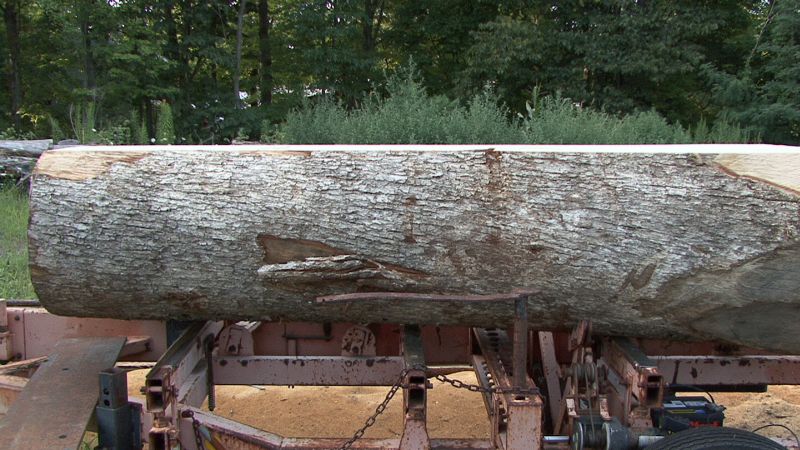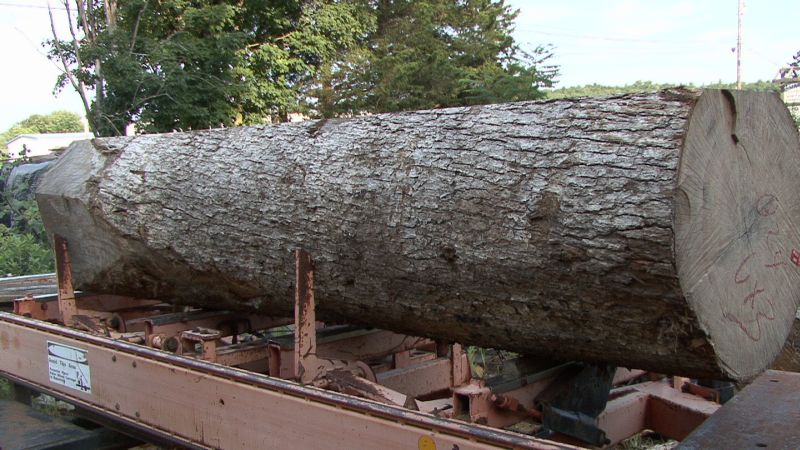Twisty Trees are Trouble
Sawyer lore says the logs with the left-handed twist are best left to rot. April 20, 2011
Question
I have a 24" diameter white oak log with spiral bark and I need to saw a few 6"x10"x 8' boards out of it. Is this going to be a problem trying to end up with timbers that will stay straight? It is not a butt log.
Forum Responses
(Sawing and Drying Forum)
From contributor Y:
Left-handed twist is much worse than right-handed twist. As you stand in front of a standing tree and hold your hands out toward it with thumbs up and fingers out, if it twists up the tree in the direction the left fingers are pointing it is left handed twist.
From contributor X:
I've never heard that before Contributor Y that's interesting.
From contributor B:
If I were you I'd cut them big and let them air dry, then trim to size. I sure wouldn't gamble much on their staying straight. That left/right thing is interesting.
From contributor Y:
I believe Scandinavian log home builders were the oldest group historically to notice the problem with left hand twisted logs but it probably goes way back. In a log home, a left handed twisted log will buck up the stacked wall. In early telegraph days, Pony Express era, they noticed some telegraph poles would twist, leaving the lines slack on one side and busting tight on the other. Next time you are in a parking lot with wood poles holding up the lights, look up and see if any of the light fixtures are out of square with the others. If you find one that is, dollars to doughnuts, it will be left-handed twist.
From contributor A:
The left hand twisted tree will cause problems. If you are in the woods and see a snag of a tree or an old hollow one most of the time the thing will have a left hand twist. I was taught that left hand twisted trees were to be left for firewood.
From the original questioner:
The bark I assume spirals to the right on this log. How will these timbers move when sawn - twist or bend?

Click here for higher quality, full size image
From contributor X:
It's a right spiral alright. I just never noticed any difference in the stress release. I haven't cut many spiraled ones though. But I don't doubt the word of these more experienced sawyers - glad I noticed this thread I will be managing a small portion of a fairly large timber harvest for the big lake.
From the original questioner:
Here’s a look from the other side. What caused this spiral? Was it a leaner?

Click here for higher quality, full size image
From Gene Wengert, forum technical advisor:
Spiral grain is caused by genetics. As discussed the defect you will see is twist. In years past, such a log would be split in two and then sawn parallel to the split to avoid twist in items such as barrel raves, shakes, etc. Note that splits will follow the spiral and splits of more than 1:12 slope will be a defect in FAS in most cases.
From contributor B:
A few years back I was in to trying to make longbows, and the first thing was to find a good stick; it had to split straight along the length, amongst other things. Easier said than done. Even a little twist would exaggerate itself as the stave dried. The same for slicing lumber. If the log is twisted it will twist as it dries. If it is a bent log it will bend as it dries. A combination will do both. Generally though, if you can get it to stay straight it will be more attractive to look at as the grain highlights when it moves across the surface.
From contributor Y:
I like the idea of over sizing them and re-sawing after some air time, if that is an option. If that is an 8' long log and the spiral goes a quarter turn in the length over a 24" diameter, then would that be a 1:8 slope?
From contributor B:
My understanding of slope would mean that the grain would move 1" away from a straight line (measured along the center of the log) in 12" to be a 1:12 slope.
From contributor A:
This is kind of like the water going down the drain. It may be genetics or just the fact that tornados spin counter clockwise. But the thing I have noticed is that almost all trees have a right hand twist. There are very few that grow straight up. Start splitting long staves for a bow or handle and you will soon notice this. Most trees that have a left hand twist seem to be of less quality trees. I see more old snags and hollows that are of the left hand twist. The tree in the photo will saw out just fine.
From Gene Wengert, forum technical advisor:
Water can go the drain in either direction. The Coriolis force that reverses when crossing the equator can affect the spinning of a storm by one revolution per day, so it cannot affect water in a drain. The Slope of grain (SOG) is a great strength reducer as well in construction lumber.
The comments below were added after this Forum discussion was archived as a Knowledge Base article (add your comment).
Comment from contributor A:
In my experience the only time left hand twist is worse than right is when a right handed individual is attempting to hew a log. In this scenario the grain on the underside is always trying to dive in right where you can't see it. After a few minutes of this it seemed apparent to me where the adage came from. Other than that twist seems to be twist no matter the direction.

